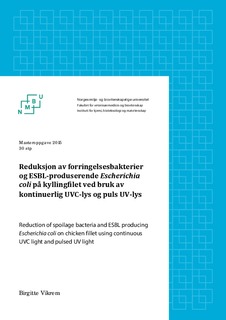| dc.description.abstract | Food safety and quality assurance of fresh poultry products involves several challenges in
today’s poultry industry. Microbial requirements have created increased demands in the
development of new methods for improved product quality. In recent years, the use of
ultraviolet (UV) light as a decontamination method has been met with increasing interest.
The aim of this thesis was to investigate the effect of UV light on microbial flora associated
with fresh, skinless chicken fillets. By illuminating chicken samples with continuous UVC
light and pulsed UV light, reductions in the number of added bacteria were examined.
Antibiotic resistant mutant strains of the spoilage bacteria Carnobacterium divergens and
Pseudomonas spp., were in addition to ESBL producing Escherichia coli added to chicken
fillets in the UV experiments. In the continuous UVC light experiments, samples were
exposed for 5, 10 and 30 seconds and 1 and 5 minutes, at a wavelength of 253,7 nm and
intensity 10 mW/cm2. Samples illuminated with pulsed UV light were exposed to different
UV doses between 1,6 and 18,0 J/cm2. No major differences between the applied illuminating
methods were observed in relation to the number of bacterial reductions. The general
reductions for all bacterial species were in the range between 1,0-3,0 logs CFU/cm2 chicken
fillet. The results indicated good killing effect regardless of UV dose used, and increasing
dose gave only minor increase in the number of log reductions. Changes in the quality or
sensory properties as a result of illumination were assessed by a professional sensory panel
and by a smaller consumer test. Only minor changes in sensory properties and product quality
could be noticed when the fillets were exposed to the highest doses. The consumers could not
differentiate the illuminated chicken samples from an untreated control sample.
Experiments showed that illumination using continuous UVC and pulsed UV light were
effective, quick and easy methods for reducing bacterial counts of C. divergens, Pseudomonas
spp. and ESBL producing E. coli. The methods resulted in only marginal changes in sensory
properties. | nb_NO |

